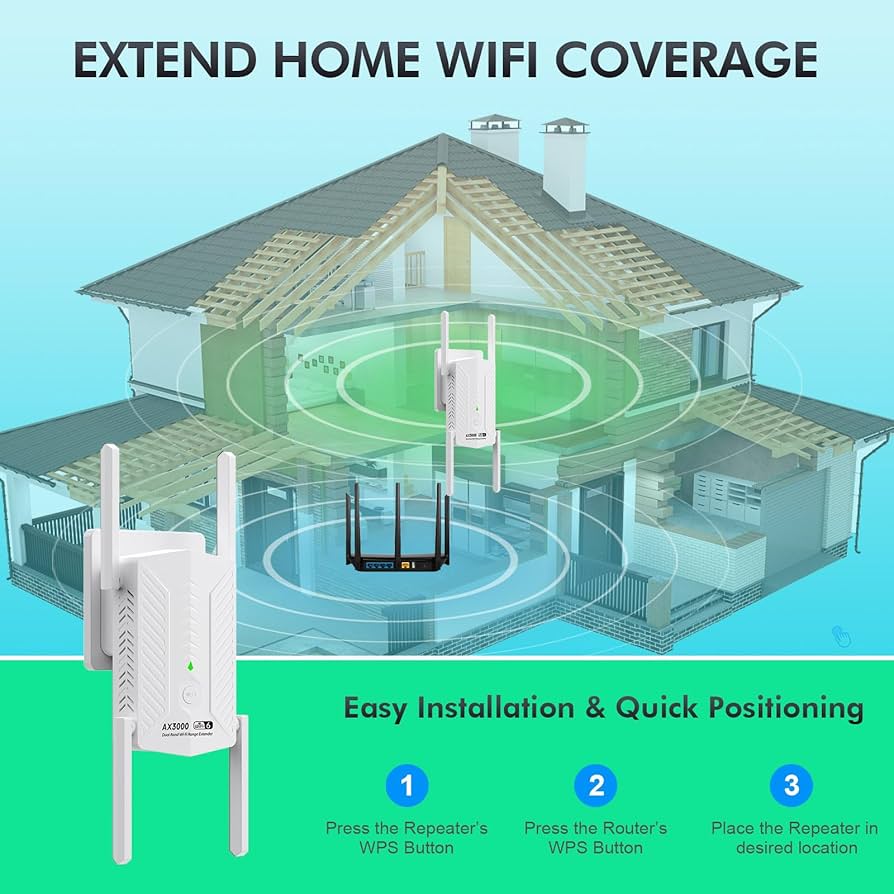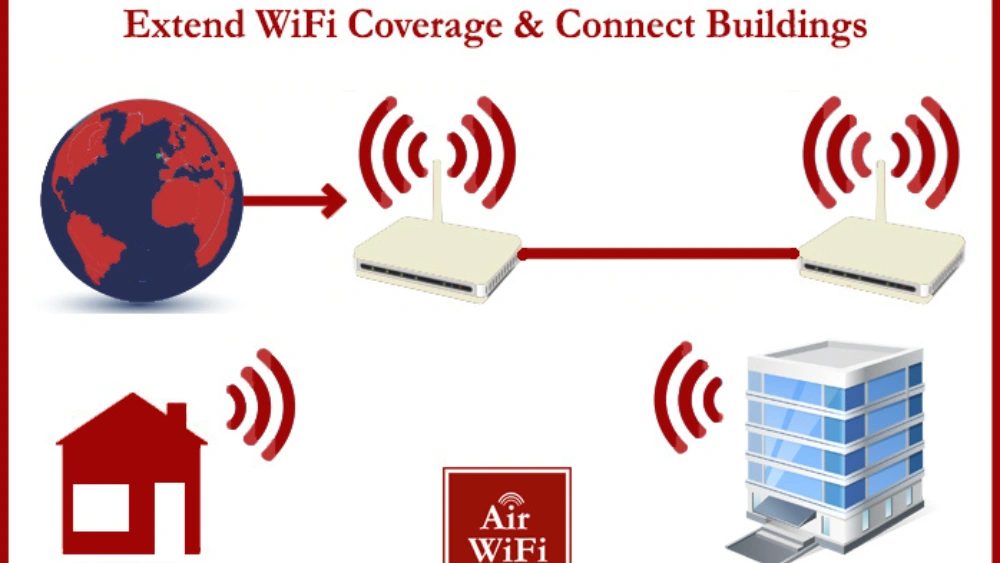Are you struggling with weak WiFi signals in a separate building on your property? You’re not alone.
Whether it’s a garage, guest house, or home office, getting a strong and reliable connection outside your main building can be frustrating. But don’t worry—extending your WiFi doesn’t have to be complicated or expensive. You’ll discover simple, practical ways to boost your WiFi signal and enjoy seamless internet access wherever you need it most.
Keep reading to find the solution that fits your space and your budget perfectly.

Credit: www.amazon.com
Assess Your Current Wifi Setup
Extending WiFi to another building starts with knowing your current setup. You need clear information about your router and signal reach. This helps you choose the right tools and methods for extension.
Check Router Placement
Router location affects signal strength a lot. Place it in a central, open spot inside your home. Avoid walls, metal objects, or thick furniture near the router. High placement often improves coverage. Check if your router is near windows or outside walls. This can help or hurt signals going to the other building.
Measure Signal Strength
Use a WiFi analyzer app on your phone or laptop. Walk around your property and note signal levels. Strong signals show good coverage. Weak signals mean the router struggles to reach that area. Record signal strength inside the main building and near the other building. This data helps decide on repeaters, extenders, or new access points.
Identify Dead Zones
Dead zones are places with little or no WiFi signal. These cause slow or lost connections. Check corners, basements, and the other building for dead zones. Mark these areas clearly. Knowing dead zones helps you plan where to add devices. Fixing dead zones improves overall WiFi performance and user experience.

Credit: www.cranegardenbuildings.co.uk
Choose The Right Extension Method
Choosing the right way to extend WiFi to another building depends on several factors. Consider the distance between buildings, obstacles, budget, and desired speed. Each method has its strengths and fits different situations. Understanding these options helps you pick the best solution for a strong and reliable connection.
Wifi Range Extenders
Wifi range extenders boost your current signal to reach farther areas. They are easy to set up and affordable. Ideal for short distances with few walls. Extenders repeat the signal but may reduce speed. Best for smaller gaps between buildings.
Mesh Wifi Systems
Mesh systems use multiple devices to create one large network. They offer seamless coverage across wide spaces. Devices work together to avoid dead zones. Mesh is simple to manage through an app. Good choice for complex layouts and multiple buildings.
Powerline Adapters
Powerline adapters send internet through electrical wiring. Plug one adapter near your router, the other in the distant building. No new cables needed. Speed depends on wiring quality and distance. Suitable for buildings with reliable electrical connections.
Point-to-point Wireless Bridges
Wireless bridges create a direct link between two buildings. They use antennas to send strong signals over long distances. This option offers high speed and stability. Requires clear line of sight between buildings. Perfect for separated structures with no wiring.
Plan For Outdoor Wifi Coverage
Planning for outdoor WiFi coverage is essential when extending your network to another building. Outdoor environments have unique challenges like weather, obstacles, and distance. Proper planning ensures a strong, stable connection that reaches your target area without interruption.
Think about the location, weather conditions, and signal path. These factors affect the WiFi signal quality outdoors. Preparing well prevents common issues such as weak signals or equipment damage.
Use Weatherproof Equipment
Choose access points and cables designed for outdoor use. Weatherproof devices resist rain, wind, and dust. This durability keeps your WiFi running smoothly all year.
Look for devices with an IP65 rating or higher. This rating ensures protection against water jets and dust. Protecting your hardware reduces maintenance and replacement costs.
Positioning Outdoor Access Points
Place access points where they have a clear line of sight. Avoid walls, trees, and large metal objects that block signals. Mount devices high to reduce interference from ground obstacles.
Consider the distance between buildings. Use a WiFi range calculator to estimate coverage. Position devices to cover the entire outdoor area evenly.
Ensure Proper Antenna Alignment
Align antennas to focus the signal toward the other building. Directional antennas work best for long-distance connections. Adjust the angle carefully to avoid signal loss.
Check antenna settings regularly. Small misalignments cause big drops in signal strength. Proper alignment maximizes coverage and speed between buildings.

Credit: www.reddit.com
Set Up Wired Connections
Setting up wired connections is one of the most reliable ways to extend your WiFi to another building. Unlike wireless solutions, a wired connection provides a stable, high-speed link that is less affected by walls, weather, or interference. It may require more upfront effort, but the consistent performance you gain is worth it.
Running Ethernet Cables
Running Ethernet cables between buildings might seem daunting, but it’s simpler than you think. You’ll need to dig a trench or find a path to lay the cable underground or above ground safely. Use conduit pipes to protect the cables from moisture and physical damage.
Think about the distance between buildings. Ethernet cables have limits—typically around 100 meters for standard Cat5e or Cat6. If your buildings are farther apart, consider using fiber optic cables or network switches to boost the signal.
Using Outdoor Rated Cables
Not all Ethernet cables are built to handle outdoor conditions. Outdoor rated cables have UV-resistant jackets and waterproof coatings that prevent damage from sun, rain, and temperature changes. Using these cables can save you from frequent replacements and connectivity issues.
Look for cables labeled “direct burial” or “outdoor” to ensure durability. If you run cables above ground, secure them properly to avoid strain or accidental cuts. Have you checked your cable’s specifications before installation? This small step can prevent a lot of headaches.
Connecting To Secondary Access Points
Once your wired connection reaches the other building, you’ll need to set up a secondary access point to broadcast WiFi there. This device acts like a new router, creating a strong signal for all your devices inside. Choose an access point that supports your main router’s speed and security settings.
Connect the secondary access point directly to the Ethernet cable and place it centrally in the building for best coverage. You can manage both the primary and secondary access points from one interface if your router supports mesh networking. How well is your current router setup optimized for adding a secondary access point?
Optimize Network Security
Extending your WiFi to another building brings convenience but also increases your network’s exposure to security risks. Optimizing network security is crucial to protect your data and devices from unauthorized access. It’s not just about setting up a connection; it’s about making that connection safe and reliable.
Secure Wireless Connections
Make sure your wireless connection uses a strong password that is hard to guess. Avoid default or simple passwords like “12345678” or “password.” Change your router’s default login credentials to prevent easy access.
Consider disabling SSID broadcasting for the extended network so it’s not visible to everyone. This adds a layer of stealth, making it harder for outsiders to find your network. You can also whitelist devices by allowing only specific MAC addresses to connect.
Use Strong Encryption
Always use WPA3 encryption if your equipment supports it; it’s the most secure option available. If not, WPA2 is the minimum standard you should accept for protecting your wireless signal.
Weak or no encryption leaves your network vulnerable to hackers who can intercept data or inject malware. Encrypting your network traffic ensures that even if someone intercepts your signal, they can’t read the information.
Implement Network Segmentation
Separate your extended WiFi network from your main network by using VLANs or guest networks. This limits access to sensitive devices like computers or printers on your main network.
By segmenting your network, you reduce the risk that a breach in the extended building will compromise your entire system. It also makes managing permissions easier, so you can control who accesses what.
Test And Troubleshoot The Connection
Testing and troubleshooting your WiFi connection is vital to ensure stable coverage in another building. This process helps identify weak spots and fix issues early. It keeps your network fast and reliable.
Check Signal Quality
Start by measuring the signal strength near the target building. Use a WiFi analyzer app to see signal bars and signal-to-noise ratio. Look for areas with low signal or high interference. Strong signals mean better connection and speed.
Check for obstacles like walls, trees, or metal objects blocking the signal path. These reduce signal quality and cause drops. Clear lines of sight improve WiFi performance.
Adjust Device Placement
Move your WiFi extender or access point for better coverage. Small changes can make a big difference. Place devices higher and near windows or doors facing the other building. Avoid placing them near thick walls or electronics that cause interference.
Test the connection after each move. Find the spot where the signal is strongest and stable. This step helps maximize coverage without extra equipment.
Monitor Network Performance
Use speed tests to check upload and download rates regularly. Slow speeds indicate possible interference or poor device placement. Watch for connection drops or delays during use.
Keep track of network performance over several days. It reveals patterns and helps spot issues during peak hours. Adjust settings or reposition devices based on your findings to keep the network smooth.
Maintain And Upgrade Your Network
Maintaining and upgrading your network is key to keeping a strong WiFi connection in another building. Networks change and grow over time. Proper care ensures your WiFi stays fast and reliable.
Checking your network regularly helps spot issues early. Upgrades improve speed and coverage. Planning ahead saves time and money.
Regular Firmware Updates
Firmware controls your WiFi devices. Updates fix bugs and improve performance. Check for updates every few months. Install them to keep your devices secure and efficient.
Updates often add new features. They can boost your signal strength. Avoid delays by setting reminders for updates.
Replace Outdated Hardware
Old routers and extenders slow your network. They may not support new WiFi standards. Replace devices every few years to keep up.
New hardware offers better speed and range. Look for models with the latest technology. This helps cover the distance between buildings.
Consider Future Expansion
Plan for more devices or buildings. Choose equipment that can handle extra load. Think about adding mesh networks or stronger antennas.
Future-proof your network by buying scalable solutions. This avoids costly replacements later. Always check compatibility before buying new gear.
Frequently Asked Questions
How Can I Extend Wifi To Another Building?
You can extend WiFi using a wireless bridge, outdoor access points, or Ethernet cables. Choose based on distance, budget, and obstacles.
What Equipment Is Best For Outdoor Wifi Extension?
Outdoor access points and wireless bridges are ideal. They provide strong signals and withstand weather conditions for reliable connectivity.
Can I Use A Wifi Repeater Between Buildings?
WiFi repeaters work for short distances with minimal obstacles. For longer ranges or buildings far apart, use outdoor access points or bridges.
How Far Can Wifi Reach Between Buildings?
WiFi range depends on equipment and obstacles. Outdoor access points can cover up to 300 feet or more in open spaces.
Conclusion
Extending WiFi to another building is possible with the right tools. Choose a method that fits your needs and budget. Test the connection for speed and reliability. Keep devices updated for the best performance. Small steps can make a big difference in coverage.
Stay patient while setting up your network. Enjoy better internet access wherever you need it.

